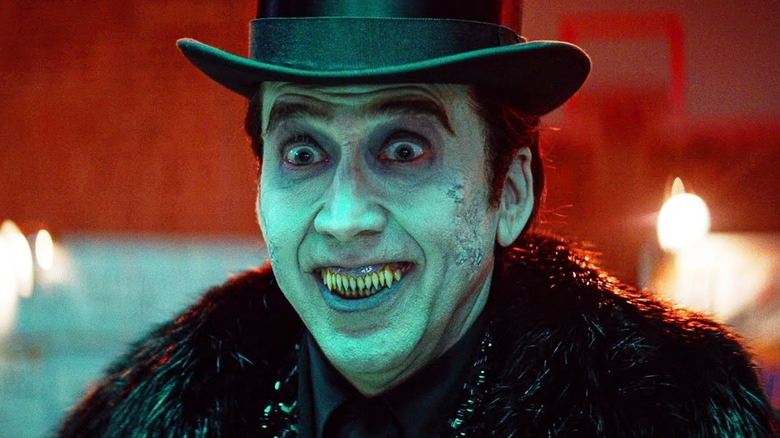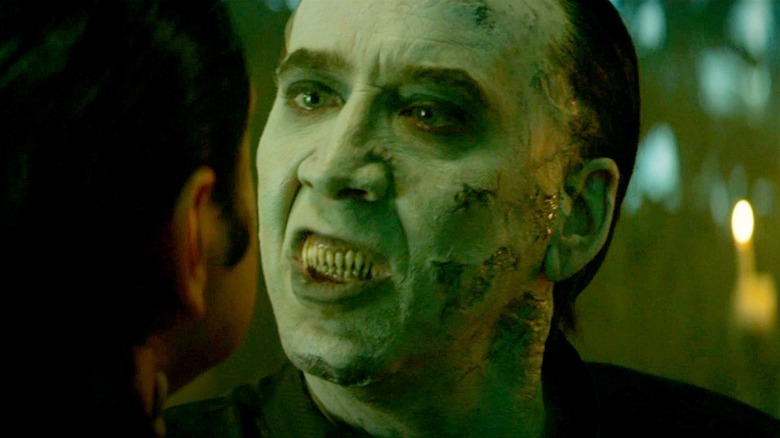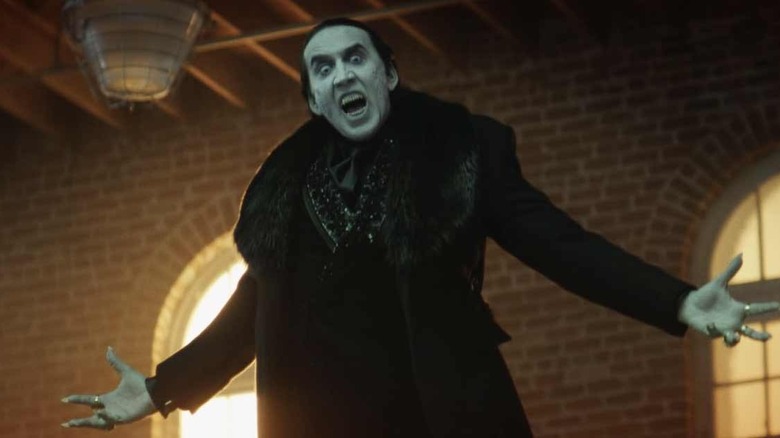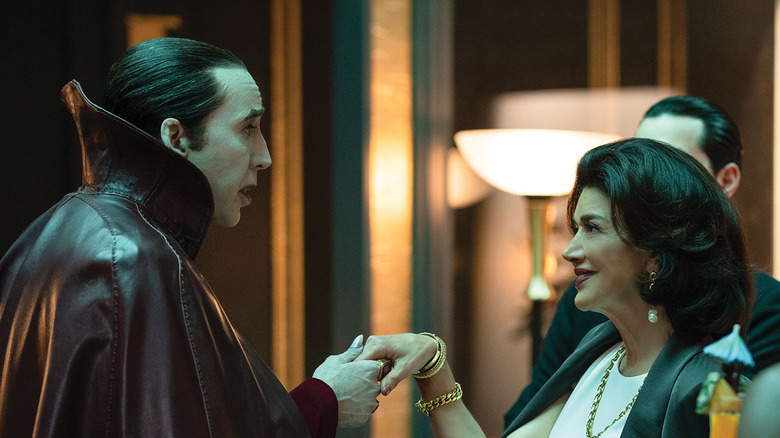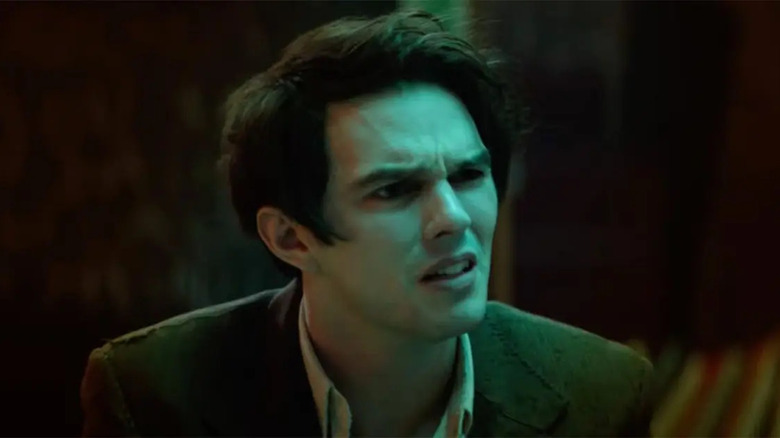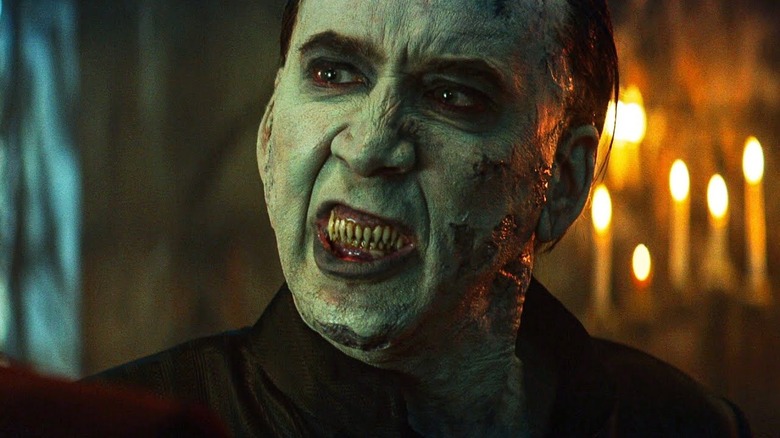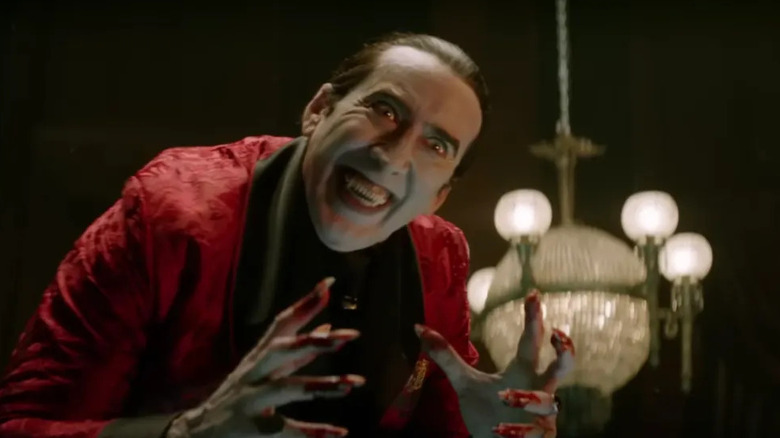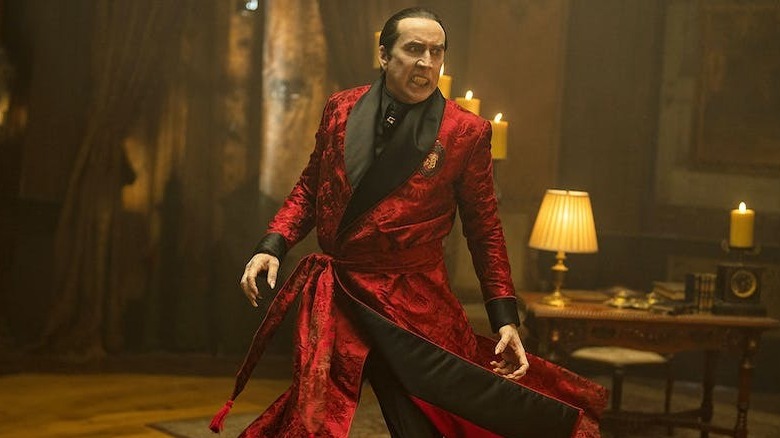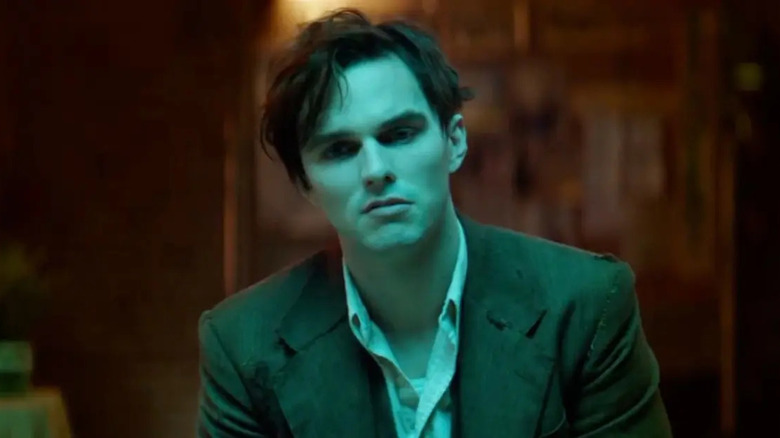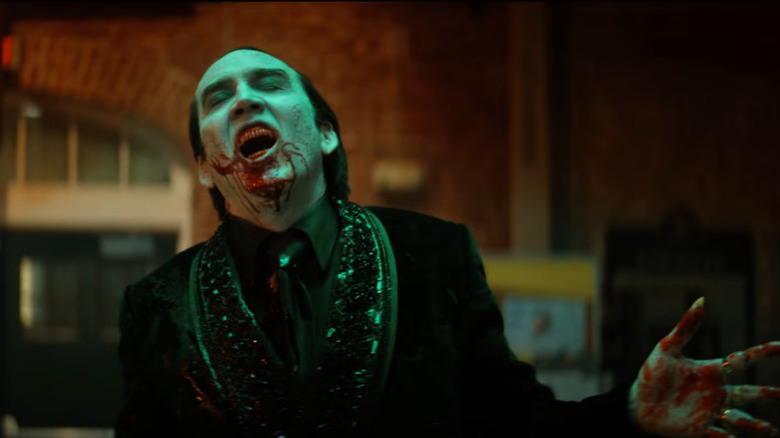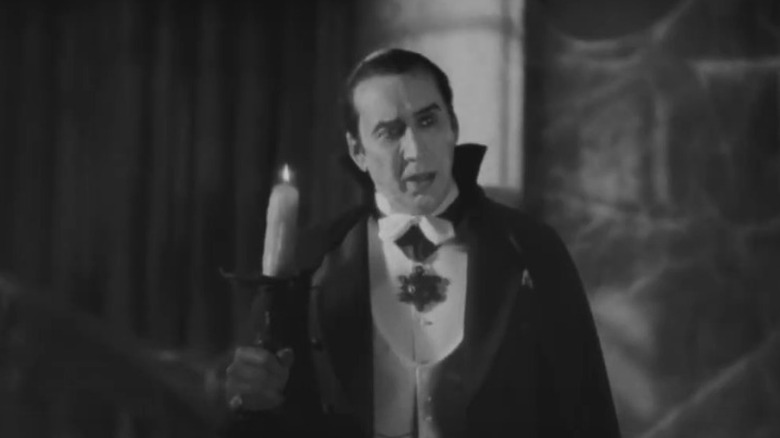The Biggest Changes Renfield Makes To Dracula Explained
Universal delivers another modern adaptation of one of their classic monsters with "Renfield," but puts the spotlight on the titular underling. The film sees Renfield (Nicholas Hoult) grappling with new realizations about his toxic relationship with his master, the nefarious Count Dracula (Nicolas Cage). However, Renfield soon realizes that splitting from the Count is far from easy, and he finds it difficult to escape Dracula's presence and influence. This sets him on a personal journey to leave his evil role in helping Dracula by aiding New Orleans police officer Rebecca Quincy (Awkwafina) in her efforts to stop a local crime family, but he ends up engaging in a bloody bout with his master.
"Renfield" doesn't forget its horror roots in the slightest, but adds dashes of action and comedy to up the bloodshed and craft hilarious depictions of legendary horror characters. The film's take on Dracula himself especially embodies this new vision for the mythos, delivering some interesting variations on longtime lore through the hilarious personality of Cage's performance. In short, the movie's version of Dracula comes with his own unique set of skills and powers that make him one of a kind. So, let's delve into how the "Renfield" movie's take on Dracula stands apart from Bram Stoker's 1897 novel and previous screen incarnations.
Immortality comes at a cost
Unless someone is able to utilize one of Dracula's well-known weaknesses, he's pretty much immortal, and taking him on in battle will generally only lead to a swift death. However, despite being immortal and all-powerful, he's not immune to taking some severe damage. Right from its opening fight sequence, "Renfield" shows that Dracula can sustain some horrific wounds. Upon being exposed to sunlight, he's engulfed in flames. Even after Renfield puts them out, the vampire is little more than a charred mess.
With Dracula being too weak to go out and hunt for new victims, he tasks Renfield to bring corpses back to him so that he can slowly regain his power by draining their blood. While most versions of Dracula have shape-shifting and recovery powers, "Renfield" presents a fresh take on just how gross those powers could be, and the process is both hilarious and grotesque to watch. The initial burned look of Dracula is pretty funny considering how powerful he was just shown to be, and watching him slowly regain flesh and bone makes Dracula's regeneration process a superb slice of body horror. Dracula's immortality might make him a tough foe, but this god-awful regeneration process makes his power come at quite a cost.
Not just a single bat
Dracula's ability to turn into a vampire bat is one of his most well-known powers, and it naturally makes an appearance in "Renfield." However, it's vastly different than in Stoker's novel. Rather than turn into a single vampire bat like usual, Dracula turns into a whole swarm of bats who terrorize anyone who gets in their way. There are literally tons of bats in this swarm, and it's not only a way for Dracula to blend in better against the night sky, it also works in quickly overwhelming enemies.
Dracula uses this ability multiple times throughout the film, and it even protects him from being torched by the sunlight in the finale. Plus, it makes things much more confusing for those trying to kill him, since it seems like every bat would need to be killed to really damage Dracula. The movie's depiction of Dracula's iconic transformation ability really ups the ante by upping the quantity of bats, and it ends up being a versatile part of Dracula's combat, making him more of a monstrous threat.
More than one familiar
Having been introduced in Stoker's original novel, Renfield has been Dracula's main familiar throughout most of his incarnations, and even other vampire films generally establish a single familiar for their central vampire. However, "Renfield" makes the case that Dracula can have multiple familiars under his control, and basically create a powerful army of followers. Dracula mentions to Renfield that his plan is to achieve world domination and that humanity will simply have to choose to become followers or food. This is the first hint that Dracula can have multiple familiars, and he eventually makes that idea a reality in the film's finale.
After cozying up with the Lobo crime family, Dracula decides to make Teddy (Ben Schwartz) and his cohorts his familiars, granting them the same kind of strength and power that Renfield has been using in battle. This version of Dracula could really have a powerful army at his disposal, and nearly is able to get the ball rolling on his world dominating plans. The idea of him having a ton of Renfields is legitimately scary, and instantly makes this version much more dangerous than previous incarnations.
Giving away his power
In most of his incarnations, Renfield's love of eating bugs is simply another creepy layer to his character. He's compelled to consume whatever small lives he can get his hands on, but there's little evidence that it gives him supernatural strength. But here, Renfield's insect appetite plays a big role in him becoming a fearsome fighter, as ingesting bugs allows him to tap into Dracula's power. He's able to showcase some immense strength, agility, and durability while also being nearly as unkillable as the vampire lord. There's even a moment when Renfield has his gut split open and he uses regenerative powers to stay alive. Renfield's ability to gain power through eating bugs is a big change for the character, but it also signifies a big change for Dracula as well.
It's pretty rare to see Dracula willingly give his power to anyone else, so the fact that he gives it to not only Renfield, but other familiars he creates as well is pretty noteworthy. It makes sense since, Renfield having powers makes it easier for him to defeat any resistance he faces while trying to get blood for Dracula. It's really a benefit to Dracula more than anything, and if he was able to create a loyal army that utilized his power like he wanted to, he likely would've been unstoppable.
Growing fangs
Dracula's fangs are not only a key part of his unsettling look, but they obviously help him drink the blood of his victims. In "Renfield," there's a moment when they're ripped away from him by our hero and actually used as weapons against him. Renfield is able to get Dracula to bite into him so deeply that his fangs end up getting stuck and are suddenly ripped out. Renfield then decides to try and fight Dracula with them since they're incredibly sharp, and they end up being an effective tool that leaves some deep cuts in the vampire.
However, Dracula unexpectedly is able to regrow his fangs in an instant, making it impossible to keep him from drinking blood. It's also shown that Dracula can actually cause his fangs to extend further outside of his mouth, making for a very creepy visual and adding to his ability to drink blood. It's already tough enough to really kill Dracula, but this addition of him not ever being able to truly lose his fangs makes him much more daunting a foe.
Whispering influence
Dracula has been known to hypnotize and manipulate people into doing his bidding, and that remains the case in "Renfield." However, there's a new dimension to his control over others that borders on horrific stalking. Though Stoker's Renfield (as he does in most adaptations) claims to hear commands from Dracula even miles away, it's rarely as literal as it is in this movie. Here, Dracula is able to communicate with him telepathically, and remains a constant voice in his head throughout nearly everything he's doing. It's even worse because Dracula talks to Renfield with this whispering voice that easily invokes chills because of how haunting it is.
It's honestly very creepy how Dracula is so obsessed with constantly being in the minds of those around him, and it shows how toxic he is to Renfield as his boss. Dracula takes his role as master to all new levels of horror with this whispering telepathy, and it's a big reason why Renfield is so ready to be released from his role as Dracula's body-bringer. We've seen Dracula be a creepy force to those he encounters before, but "Renfield" showcases him really over-stepping some personal space and being a remarkably creepy control-freak who will do anything to get his way.
Dracula doesn't care to blend in
It's not uncommon to see Dracula exist in more modern settings, but he usually tries to blend in with the times. He'll change his clothes to look more like everyday folk, or he might even drop his accent to not stand out too much. Here, though, Dracula doesn't care to blend in whatsoever, and looks basically the same no matter how much time passes. Renfield uses more modern material when dressing Dracula, but his style hasn't changed in the slightest, and he definitely looks of his era.
His more Gothic style garb is very apparent when he walks into Renfield's support group meeting wearing a old-fashioned top hat, antique cane, and a trench coat he likely stole from Jack the Ripper. Dracula doesn't care to look modern and hip, and is likely only concerned with maintaining his power. Dracula's clothes and sense of style further show how stuck he is in his ways, and it's a visual reminder that regardless of how much Renfield desires a change in their dynamic, Dracula will never give it to him.
Dracula's chaotic cycle
As explained by Renfield, Dracula is caught in a major rut that sees him constantly gain and lose power. Every time he's able to reach full power, he goes on an absolute killing spree that leaves a trail of blood in his path and causes enemies to come and fight him. While Dracula generally comes out victorious in these fights, he's usually left in a damaged state that keeps him sedated for decades while he regains power. This isn't an unexpected cycle for someone like Dracula, but its specific depiction in "Renfield" makes the movie's take on the material unique.
This chaotic cycle of killing and caring that Renfield goes through with Dracula has completely worn him down, and now has him looking for an escape. As for Dracula, his ability to slowly recover without the worry of dying has made him become uncaring towards the whole thing, and much more narcissistic about his power. This terrible rut is the crux of Renfield and Dracula's conflict in the film and a big reason why Dracula feels so much more toxic as a master.
The Count of Comedy
Dracula is one of the most notable figures in horror for a reason — his powers and thirst for blood make him one of the scariest monsters in the genre. While there's still something disturbing and very scary about Dracula in "Renfield," he's much more comedic here, and it's largely because of who's playing him. Cage taking on the role of Dracula instantly adds some comedic underpinnings to the portrayal, since that unique Nicolas Cage brand of outlandish acting is hard not to find hilarious.
His reactions to Renfield and condescending methods of maintaining his power never stop being funny, and Cage does a great job making Dracula a hilarious boss from hell. Even when he's at his nastiest and showing some skin-crawling deception, there's a part of Dracula's demeanor and Cage's performance that's tough to not crack a smile at. While Cage still is able to create a haunting aura around Dracula's persona, he really does what he does best in "Renfield" — adding some light-hearted hilarity to serious moments and characters. He's certainly the funniest version of Dracula to have been created thus far, and it's doubtful that any will take that crown any time soon.
Picky blood drinker
Dracula will drink the blood of nearly anyone he can get his hands on. From innocent children to vulnerable people, Dracula isn't generally squeamish about killing anyone for their precious blood. However, when Renfield brings Dracula some of the thugs he kills, Dracula is far from happy. He starts complaining about how he needs purer blood, and that one of the corpses doesn't even have its head anymore. Who knew Dracula had become such a picky eater?
He tasks Renfield with bringing him a strong smorgasbord of victims — including a busload of cheerleaders and a trio of nuns — and it's another instance of why Renfield's job is so difficult. With Dracula never wanting to make things easy for Renfield, his refined tastes add all new problems for a Renfield looking to change himself. Given how badly Dracula needs blood to regain his power and become more invincible, you would think he wouldn't be so selective about blood he's getting.
